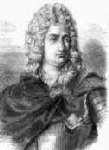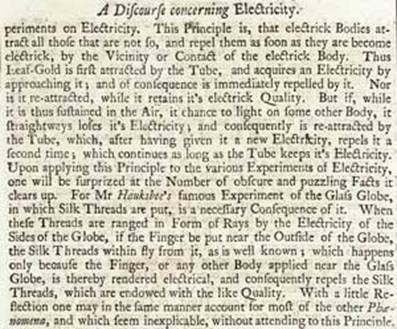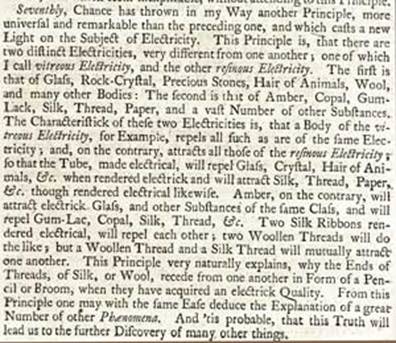Handout #2: Charles DuFay (1698-1739)
 Charles François de Cisternay DuFay, French scientist and superintendent of the Jardin du Roi of Paris, made the important discovery that there are two kinds of electricity, one produced by glass (vitreous) and the other by resin (resinous). These terms were used for fifteen years until they were replaced with positive and negative (respectively) – terms coined independently by William Watson and Benjamin Franklin. This discovery, along with Dufay's other observations on electricity, were reported in a paper written in December of 1733 and printed in Volume 38 of the Philosophical Transactions of the Royal Society in the following year (see excerpt below).
Charles François de Cisternay DuFay, French scientist and superintendent of the Jardin du Roi of Paris, made the important discovery that there are two kinds of electricity, one produced by glass (vitreous) and the other by resin (resinous). These terms were used for fifteen years until they were replaced with positive and negative (respectively) – terms coined independently by William Watson and Benjamin Franklin. This discovery, along with Dufay's other observations on electricity, were reported in a paper written in December of 1733 and printed in Volume 38 of the Philosophical Transactions of the Royal Society in the following year (see excerpt below).

Dufay's work clarified many of the unexplained phenomena associated with electricity. His outstanding contributions to the knowledge of electrical art include:
- All bodies can be electrically charged by heating and rubbing, except metals and soft or liquid bodies.
- All bodies, including metal and liquid, can be charged by influence (induction).
- The electrical properties of an object unique to color are affected by the dye, not the color itself.
- Glass is as satisfactory as silk as an insulator.
- Thread conducts better wet than dry.
- There are two states of electrification, Vitreous and Resinous.
- Bodies electrified (charged) with vitreous electricity attract bodies electrified with resinous electricity and repel other bodies electrified with vitreous electricity.
In Charles DuFay’s own words:
"I have found that all bodies (metallic, soft, or fluid ones excepted) may be made electric by first heating them more or less and then rubbing them on any sort of cloth. So that all kinds of stones, as well precious as common, all kinds of wood, and, in general, everything that I have made trial of, became electric by heating and rubbing, except such bodies as grow soft by heat, as the gums, which dissolve in water, glue, and such like substances. This also to be remarked that the hardest stones or marbles require more chafing or heating than others, and that the same rule obtains with regard to the woods; so that box, lignum vitae, and such others must be chafed almost to the degree of browning, whereas fir, lime-tree, and cork require but a moderate heat. Having read in one of Mr. Gray's letters that water may be made electrical by holding the excited glass tube near it (a dish of water being fixed to a stand and that set on a plate of glass, or on the brim of a drinking-glass, previously chafed, or otherwise warmed), I have found, upon trial, that the same thing happened to all bodies without exception, whether solid or fluid, and that for that purpose it was sufficient to set them on a glass stand slightly warmed, or only dried, and then by bringing the tube near them they immediately became electrical. I made this experiment with ice, with a lighted wood-coal, and with everything that came into my mind; and I constantly remarked that such bodies of themselves as were least electrical had the greatest degree of electricity communicated to them at the approval of the glass tube."
Additional Excerpts from Dufay's "A Discourse concerning Electricity"

